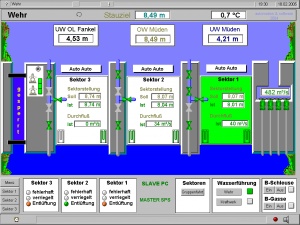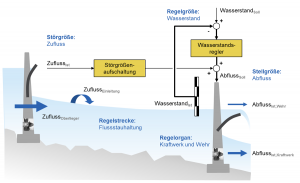Automated Discharge and Water Level Control
From BAWiki


Numerous rivers in Germany are impounded, primarily to improve conditions for shipping and also for generating energy. Efficient optimized operation of weirs, power stations and locks demands extensively automated operation. In this context, the BAW is currently involved in various barrages at the rivers Mosel, Neckar and Saar.
Automated control of a barrage requires configuration of the parameters for the control system. An OW/Q controller, which combines water level control (OW) with inflow into the controlled system (Q), is state of the art in this field. The control technology parameters must be adapted to local conditions and, in particular, must ensure that the actuator "weir" is moved as little as possible. It is not possible to derive these parameters from the operation of a barrage; they must be provided in advance. The BAW solves this task by simulating hydraulics and control technology together on the MATLAB/SIMULINK development platform.
For the hydraulic behaviour of the impoundment the unsteady flow modeling system CasControl is used, while the actuators weir and power station are mapped in the form of characteristic curves. The instrumentation, control and adjustment variables are networked together with the results obtained on site using control system and signal processing methods.
back to Hydraulic Engineering Methods
